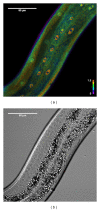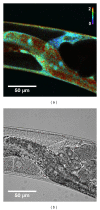ROS in aging Caenorhabditis elegans: damage or signaling?
- PMID: 22966416
- PMCID: PMC3431105
- DOI: 10.1155/2012/608478
ROS in aging Caenorhabditis elegans: damage or signaling?
Abstract
Many insights into the mechanisms and signaling pathways underlying aging have resulted from research on the nematode Caenorhabditis elegans. In this paper, we discuss the recent findings that emerged using this model organism concerning the role of reactive oxygen species (ROS) in the aging process. The accrual of oxidative stress and damage has been the predominant mechanistic explanation for the process of aging for many years, but reviewing the recent studies in C. elegans calls this theory into question. Thus, it becomes more and more evident that ROS are not merely toxic byproducts of the oxidative metabolism. Rather it seems more likely that tightly controlled concentrations of ROS and fluctuations in redox potential are important mediators of signaling processes. We therefore discuss some theories that explain how redox signaling may be involved in aging and provide some examples of ROS functions and signaling in C. elegans metabolism. To understand the role of ROS and the redox status in physiology, stress response, development, and aging, there is a rising need for accurate and reversible in vivo detection. Therefore, we comment on some methods of ROS and redox detection with emphasis on the implementation of genetically encoded biosensors in C. elegans.
Figures



References
-
- Harman D. Aging: a theory based on free radical and radiation chemistry. Journal of Gerontology. 1956;11(3):298–300. - PubMed
-
- McCord JM, Fridovich I. Superoxide dismutase. An enzymic function for erythrocuprein (hemocuprein) Journal of Biological Chemistry. 1969;244(22):6049–6055. - PubMed
-
- Chance B, Sies H, Boveris A. Hydroperoxide metabolism in mammalian organs. Physiological Reviews. 1979;59(3):527–605. - PubMed
-
- Harman D. The biologic clock: the mitochondria? Journal of the American Geriatrics Society. 1972;20(4):145–147. - PubMed
Publication types
MeSH terms
Substances
LinkOut - more resources
Full Text Sources
Other Literature Sources
Medical

